Abstract:To take into account the influence of uncetainties on the dynamic response of the vibro-acousitc structure, a hybrid modeling technique combining the finite element method (FE) and the statistic energy analysis (SEA) is proposed to analyze vibro-acoustics responses with uncertainties at middle frequencies. The mid-frequency dynamic response of the framework-plate structure with uncertainties is studied based on the hybrid FE-SEA method and the Monte Carlo (MC) simulation is performed so as to provide a benchmark comparison with the hybrid method. The energy response of the framework-plate structure matches well with the MC simulation results, which validates the effectiveness of the hybrid FE-SEA method considering both the complexity of the vibro-acoustic structure and the uncertainties in mid-frequency vibro-acousitc analysis. Based on the hybrid method, a vibro-acoustic model of a construction machinery cab with random properties is established, and the excitations of the model are measured by experiments. The responses of the sound pressure level of the cab and the vibration power spectrum density of the front windscreen are calculated and compared with those of the experiment. At middle frequencies, the results have a good consistency with the tests and the prediction error is less than 3.5 dB.
Key words:hybrid finite element method and statistic energy analysis (FE-SEA) method; dynamic analysis; vibro-acoustic system; uncertainties; mid-frequency range
The dynamic analysis of a built-up vibro-acoustic system has been a topic of interest in many industrial design fields as a way to predict noise, vibration and harshness problems (NVH) in systems. However, there is not a single method able to be employed when the dynamic behavior spreads over a wide frequency range [1-2]. Currently, the FE method[3-4]is one of the most widely-used deterministic approaches for dynamic analysis, which is built on the discretization of the system into a fair amount of elements. Whereas, as the frequency increases, the FE model will desire a large number of degrees of freedom (DOFs) so as to exactly describe short wavelength behavior of the structure, which demands a huge calculation resource and time. Furthermore, the FE model becomes more and more sensitive to randomness with the frequency increasing, which will lead to a major propagation error easily. Thus, the FE method is limited to the low frequencies for practical reasons. Statistic energy analysis[5-8] is another widely used approach from a statistical point of view, which provides statistical information and requires relatively few degrees of freedom at high frequencies. However, this method only provides the ensemble average responses of the nominally identical systems and is not capable of obtaining results at single frequencies and individual locations. Moreover, the underlying assumptions of a high modal density and modal overlap in SEA may not be valid at middle and low frequencies. Therefore, the applications of the SEA are limited to high frequencies for the reasons above.
In practice, between the low- and high-frequency ranges, there is a mid-frequency gap where mixed behaviors exist. Often some substructures have a high modal density satisfying the requirements for SEA, while the other substructures behave deterministic behaviors which are appropriate for the FE method. In the past several decades, several methods have been proposed to enhance the computational efficiency and to weaken the propagation errors in the middle frequency band. One type of modified approach is upward extension of the FE method[9-13]. Another type of modified approach is the downward extension of the SEA by relaxing the assumption of high modal density[14-15]. However, modes at a single frequency or individual location still in the mid-frequency range cannot be acquired by those mean ensemble methods.
The hybrid FE-SEA method is employed in this paper to study the vibro-acoustic responses of the framework-plate system with randomness and is applied to a construction machinery cab in mid-frequency vibro-acoustic analysis.
The vibro-acoustic system is divided initially into deterministic and statistic subsystems. The former is modeled by the FE method using dynamic equilibrium equations and the latter is described by the SEA model based on power flow equilibrium equations. Once the partition is defined, the energy reciprocity principle is applied to combine the FE and SEA models. The primary characteristic of the coupling is the view of the direct field and the reverberant field which is described using transmission and reflection waves in the interface of the subsystems.
If the DOFs of finite element parts are described as q and external forces exerted on this part are denoted as f, the dynamic equations can be represented as
(1)
(2)
where N represents the total subsystems of SEA; Dd represents the dynamic stiffness matrix of FE subsystems, which is given by the FE model; ![]() is the direct field dynamic stiffness matrix of the SEA subsystem k; Dtot represents the global dynamic stiffness matrix which consists of the dynamic stiffness matrices of FE subsystems and the direct field of SEA systems;
is the direct field dynamic stiffness matrix of the SEA subsystem k; Dtot represents the global dynamic stiffness matrix which consists of the dynamic stiffness matrices of FE subsystems and the direct field of SEA systems; ![]() is the reverberant field force from the SEA subsystem k.
is the reverberant field force from the SEA subsystem k.
Based on the reciprocal relationship of the diffusion field[16], the cross spectrum matrix of the reverberant field loads can be written as
![]() {
{![]() }
}
(3)
where E[] indicates the ensemble average and H denotes the conjugate transpose; Ek represents the energy response and nk represents the modal density of subsystem k. Eq.(3) makes a connection between the FE and SEA subsystems at the boundary. The cross-spectral matrix of the response q is written as
![]() {
{![]() }
}![]()
(4)
Eq.(4) implies that the response q is determined by the loads exerted directly on the FE part and also by the reverberant loads from the SEA part. By solving Eq.(4), one can obtain the response of the FE part.
For the optional SEA subsystem j, based on the energy equilibrium equation, the ensemble and time average power input will equal the sum of the output power and self-dissipation power. Furthermore, the power input consists of the power input of the direct field of subsystem j arising from the external loads applied to the FE part and the sum of power input arising from the reverberant field loads of subsystem k applied to subsystem j. The power output delivered to the other subsystems is divided into two components. One part is the power transmitted to the FE subsystems and the other part is the power transmitted to the other SEA subsystems described. Thus, the energy equilibrium equation of each subsystem is written as
(5)
where the power input ![]() can be computed by the displacement response qd arising from external load f applied to the subsystem j and its dynamic stiffness matrix
can be computed by the displacement response qd arising from external load f applied to the subsystem j and its dynamic stiffness matrix ![]() ; ηd,j is the coupling loss factor.
; ηd,j is the coupling loss factor.
Eqs.(4) and (5) constitute the primary equations of the hybrid FE-SEA method. Once the energy response Ej of SEA subsystem is computed by Eq.(5), the response of q is also computed by Eq.(4) eventually.
The vibro-acoustic system shown in Fig.1 is considered based on the hybrid method mentioned above. A framework-plate structure is widely used in vehicle engineering, such as the body structure of the automobile and the cab of the construction machinery. Therefore, analyzing vibro-acoustic behaviors of a system with randomness is of great engineering value to the structure design.
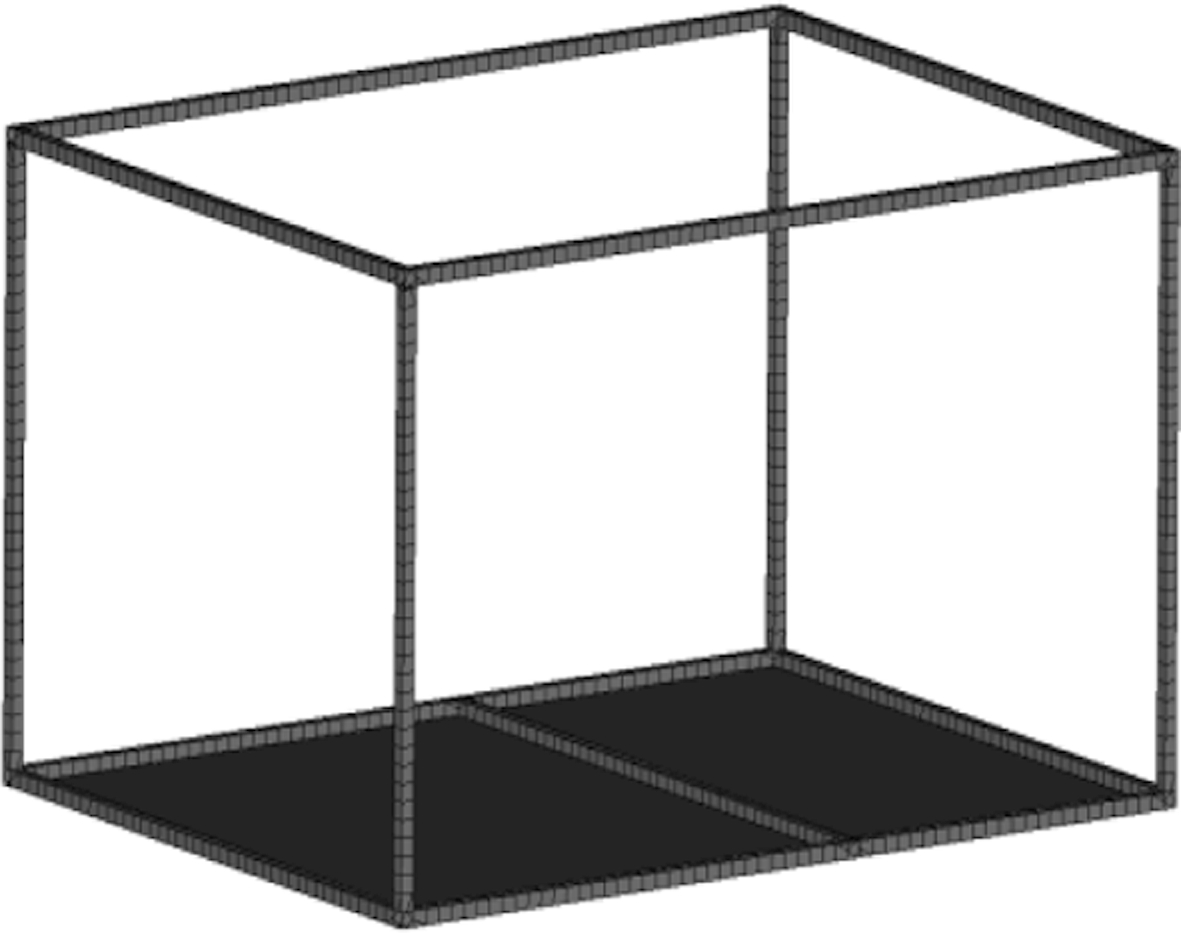
Fig.1 The framework-plate structure
The structure is composed of a beam framework with two plates which are welded to the framework along the boundaries. All components are made of aluminum, of which Young’s modulus is 71 GPa, and the Poisson ratio is 0.3, and the density is 2 700 kg/m3. The plate dimensions are all of 1.3 m×0.65 m, with a thickness of 2 mm. All the framework beams are 1.3 m in length, with a square hollow section of external side width of 22.3 mm and wall thickness of 3 mm.
The system is randomized by varying the thickness of the plates to fluctuate within the range of 20% to generate 100 samples of the framework-plate structure. A point force is exerted on one of the lower horizontal beams of the framework in the vertical direction. The damping loss factor of plates and the framework beam is 1%. Then the MC solutions for the response of randomized structures are obtained for comparison with the hybrid method. The division of the system is based on the number of modes in a certain band of frequencies (Nf=nΔf) which is used to determine whether an FE or SEA description of a subsystem is the most appropriate. The number of modes of each subsystem in the one-third octave band is plotted in Fig.2.

Fig.2 Number of modes of the plate and framework
It is shown that the mumber of modes of the plate in the same band is much more than that of the framework beam, which indicates that the dynamic response between them is remarkably distinct and it should be considered at middle frequencies.
In the hybrid model, the framework beam is modeled by FE while the plates are modeled by SEA. Then the energy response of the plate is plotted in Fig.3. The MC simulation of 100 random systems and the ensemble-averaged response are plotted with the dot line and the solid line, respectively, and the dash line curve is the hybrid method response.
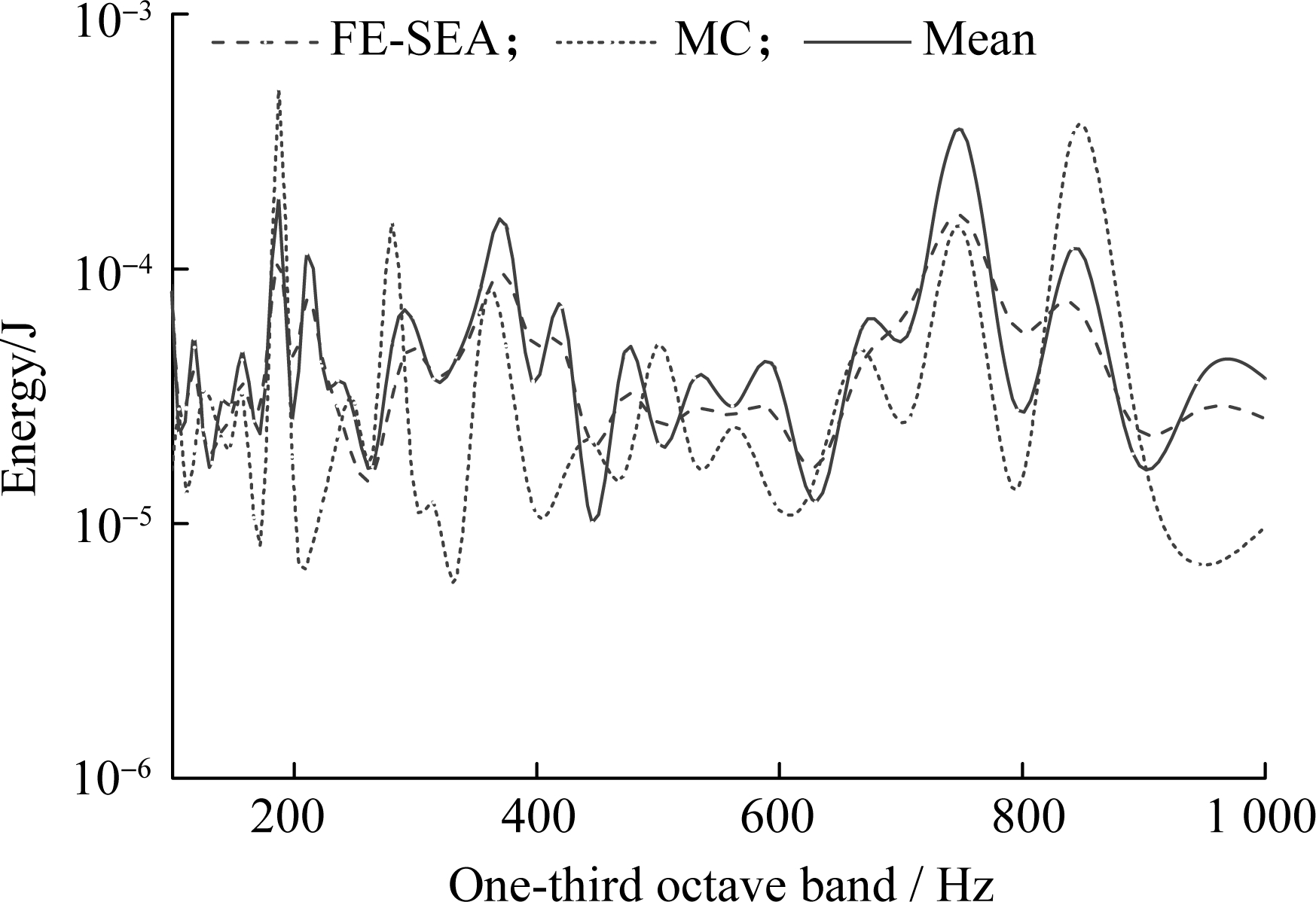
Fig.3 Plate energy responses
It is also observed that the MC simulation is extremely sensitive to randomness and the hybrid result almost matches the ensemble-averaged reference at the frequency of the various peaks in the response. This indicates that the hybrid method is capable of catching modal behaviors of the ensemble-averaged response arising from the deterministic subsystem with robust dynamics. Additionally, peaks of the hybrid FE-SEA response approximating the natural frequencies indicate that the global mode is governed by the deterministic subsystem. Some discrepancies between the ensemble average and the hybrid method are likely due to the limited samples used in the MC method. Moreover, the possible reason for the difference is the limited amounts of uncertainty, particularly within 150 Hz, which cause the hybrid method to dissatisfy the diffusion reciprocal conditions.
As previously noted, the hybrid method combining the strength of FE and SEA can provide an efficient way of modeling the mid-frequency vibrations and predicting the average response over an ensemble of the random vibro-acoustic system at the middle frequencies. Compared with the conventional FE method, this method makes the computation efficient since all degrees of freedom associated with SEA subsystems are omitted from the hybrid model. On the other hand, the subsystems with uncertainties can be described statistically by SEA.
The vibro-acoustic analysis of the framework-cavity-plate system is a very complicated task not only due to the interaction between the acoustic cavity and the flexible structures but also due to the complexity of the model with randomness frequency (e.g.,variability of the geometry, material properties and boundary conditions). In this section, the hybrid method is used to study the vibro-aocustic response of a construction machinery cab under the air-born, and the simulation results are compared with the experimental results.
The construction machinery cab is a representative vibro-acoustic system, and it is composed of the steel rectangular hollow beams with a thickness of 4 mm. The thickness of the steel plates and laminated glasses of the cab are 1.5 and 7 mm, respectively. Material properties are given in Tab.1.
Tab.1 Material properties of the cab

MaterialDensity/(kg·m-3)Youngsmodulus/GPaPoissonratioSteel78002100.3125Laminatedglass2500620.24Air1.21
The hybrid model of the construction machinery cab is constructed by the software package VA-one, in which the framework beams are modeled by the FE method using 31 962 elements and the flexible plates (shells, glasses) and the acoustic cavity are regarded as SEA components. A modal analysis is performed on the finite element parts and 126 modes are extracted within 1 000 Hz. The parameters of the cavity can be calculated by an analytical method. The modal density n(ω) and the internal loss factor η of the cavity are given by where c is the speed of sound;As represents the surface area; V0 represents the volume of the acoustic cavity; ll represents the sum length of the boundaries and α is the acoustic absorption factor. The computed modal density of the acoustic cavity is plotted in Fig.4.
(6)
(7)
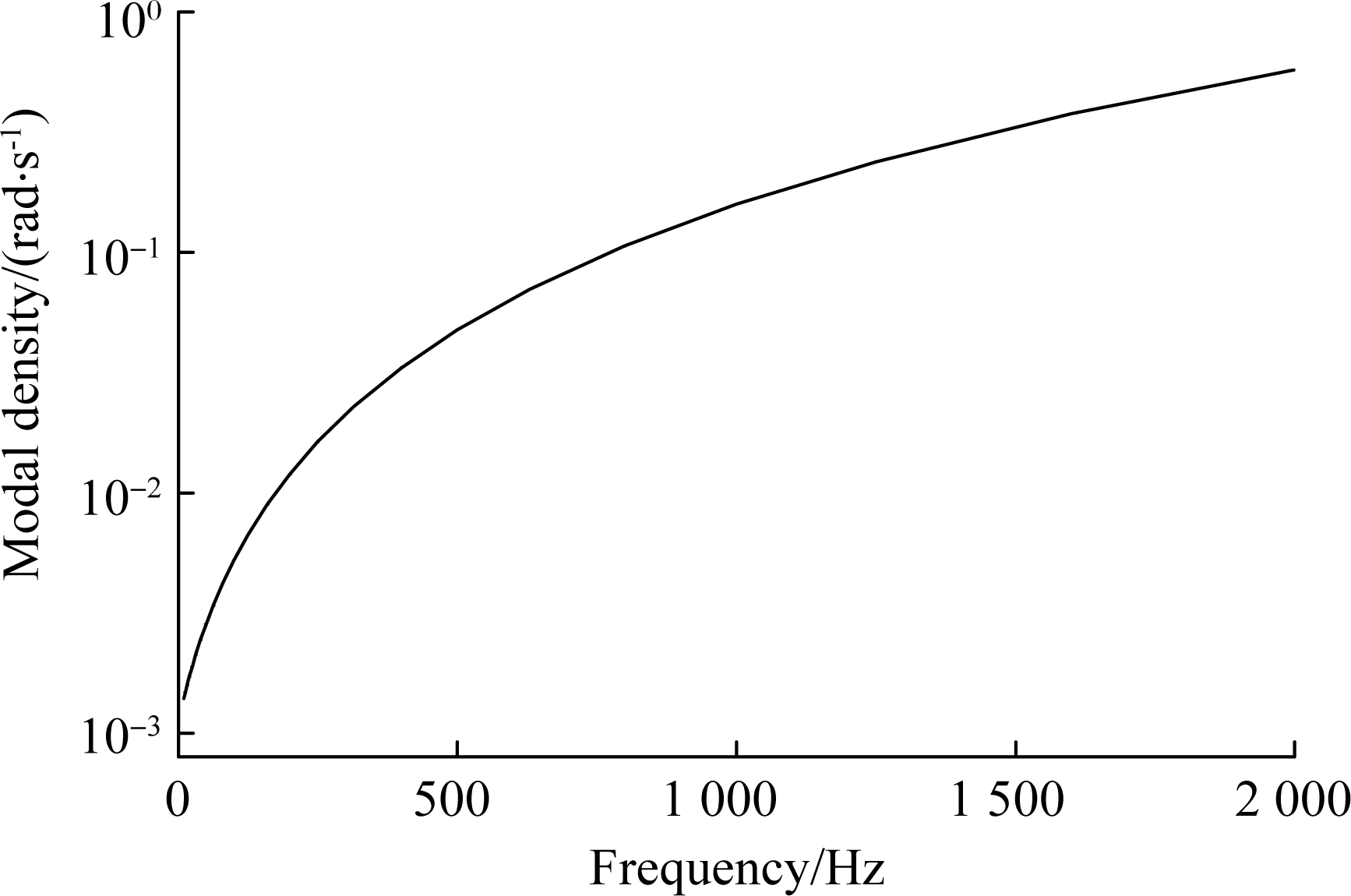
Fig.4 Modal density of the cavity
Two excitations of the acceleration and the sound pressure arising from the powertrain and exhaust noise are considered, which are acquired by experiments and the experimental results are shown in Figs.5 and 6, respectively. The averaged acceleration excitation (see Fig.5) is applied to the four cab suspensions equally and a diffuse acoustic field is applied to the cab surface to simulate the external sound pressure. Twelve acceleration sensors are placed on the surface of the cab and a microphone is placed near the driver’s ear. Consequently, the acceleration power spectrum density (PSD) of the cab’s front windscreen and the experimental results’ pressure level of the interior cavity are obtained by the hybrid method under the given excitations, and the comparison between the prediction results and the experimental results are shown in Figs.7 and 8, respectively.
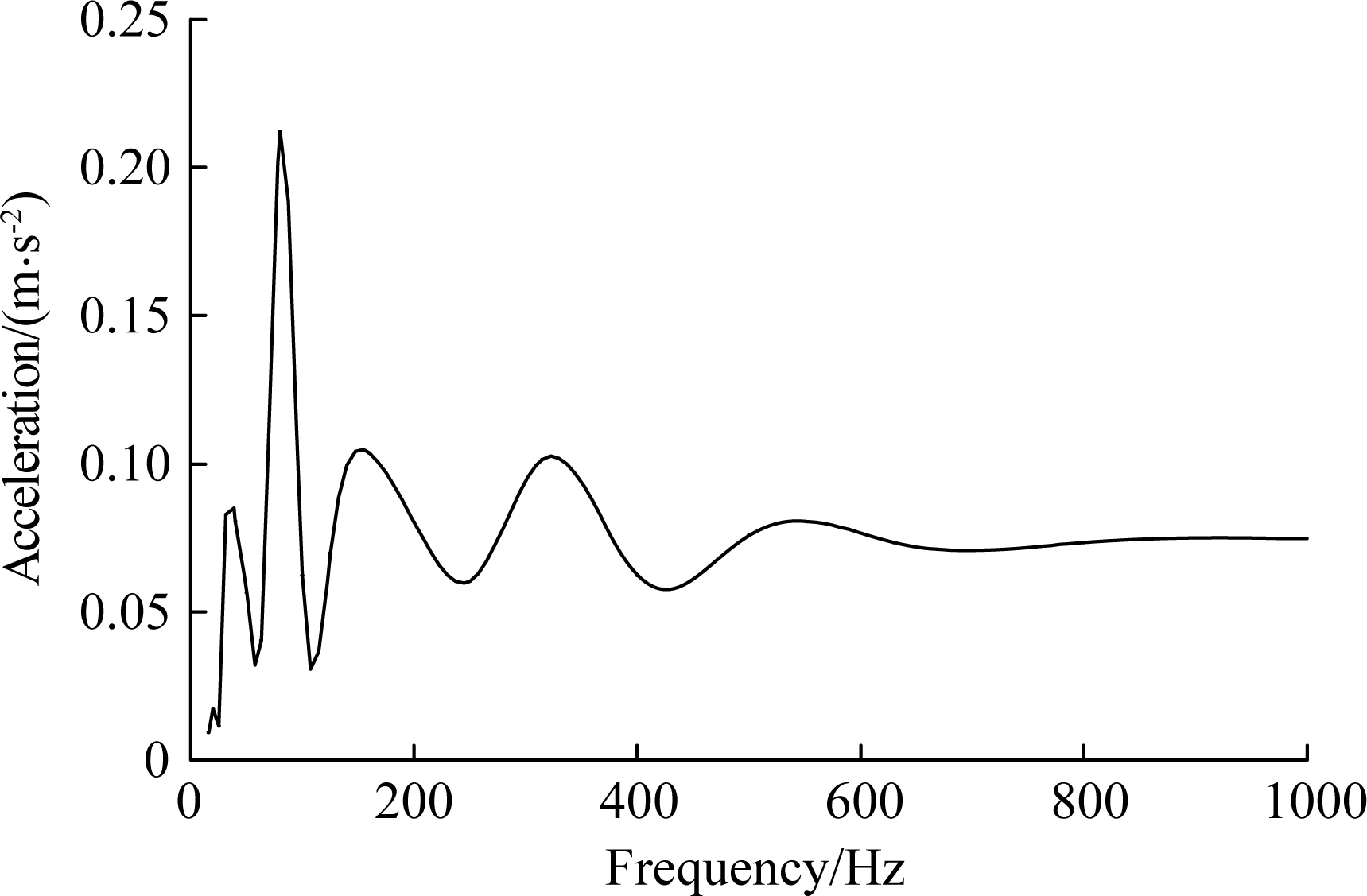
Fig.5 Acceleration excitation
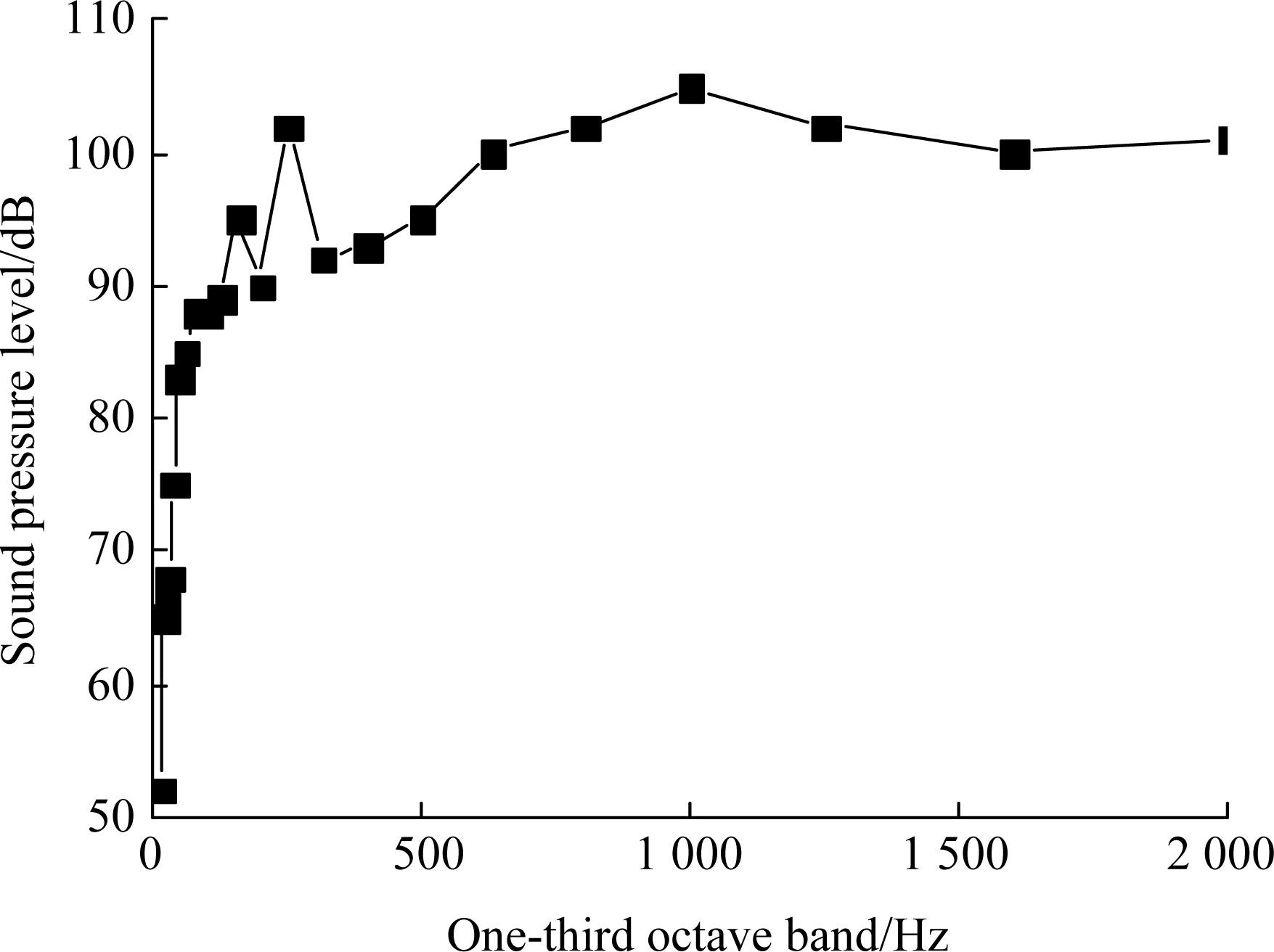
Fig.6 Sound pressure excitation
As plotted in Fig.7, the prediction of the acceleration response of the hybrid method agrees well with the test within 2 000 Hz. Furthermore, there is a peak at 250 Hz on both curves which is precisely one of the natural frequencies of the cab. It can also be seen from Fig.8 that the sound pressure levels inside the cab decrease with the frequency increasing. It may be caused by the decline of the acceleration excitation, as shown in Fig.5, which implies that the interior noise of cab arises mainly from the structural vibration.
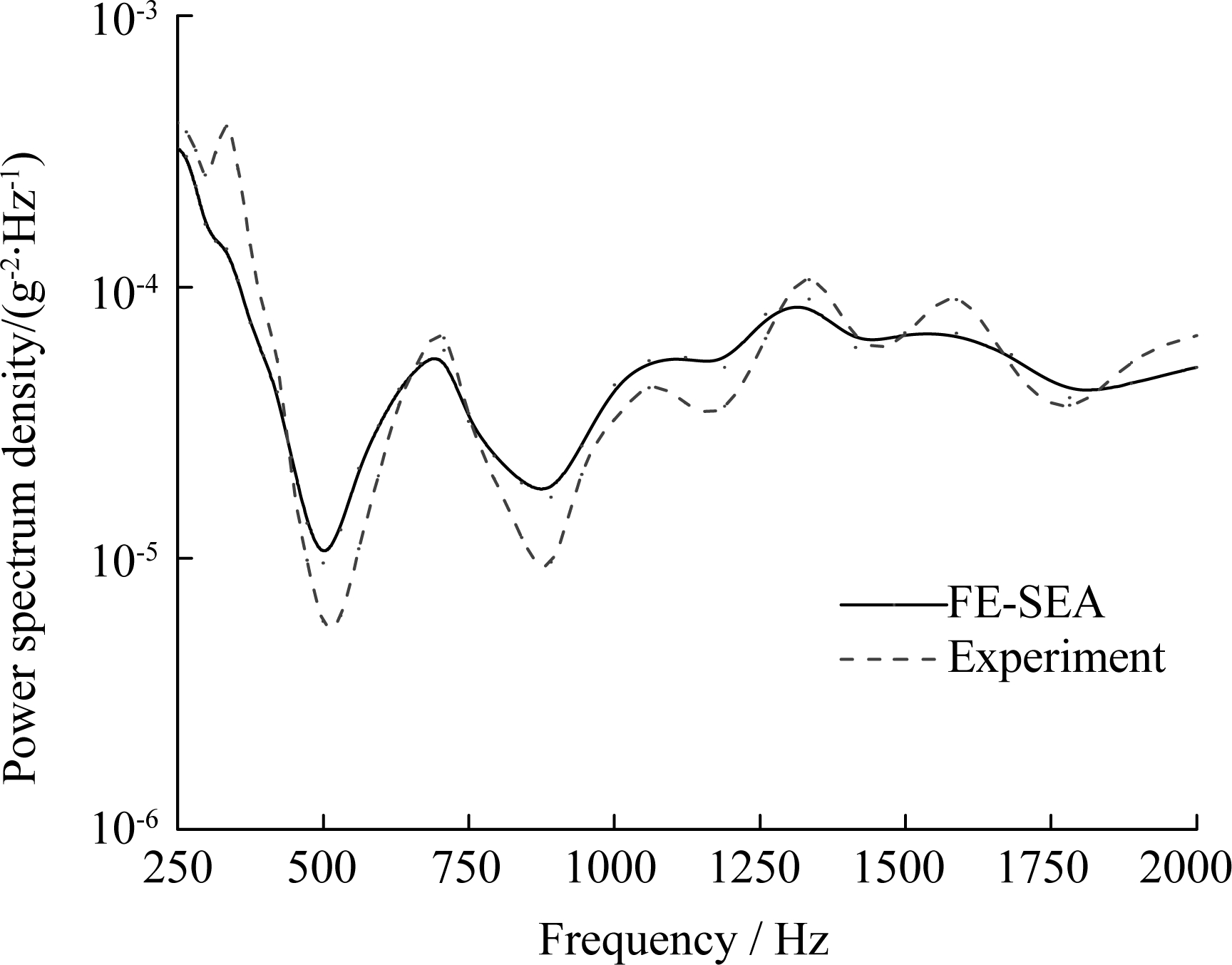
Fig.7 Acceleration power spectrum density of the front windscreen
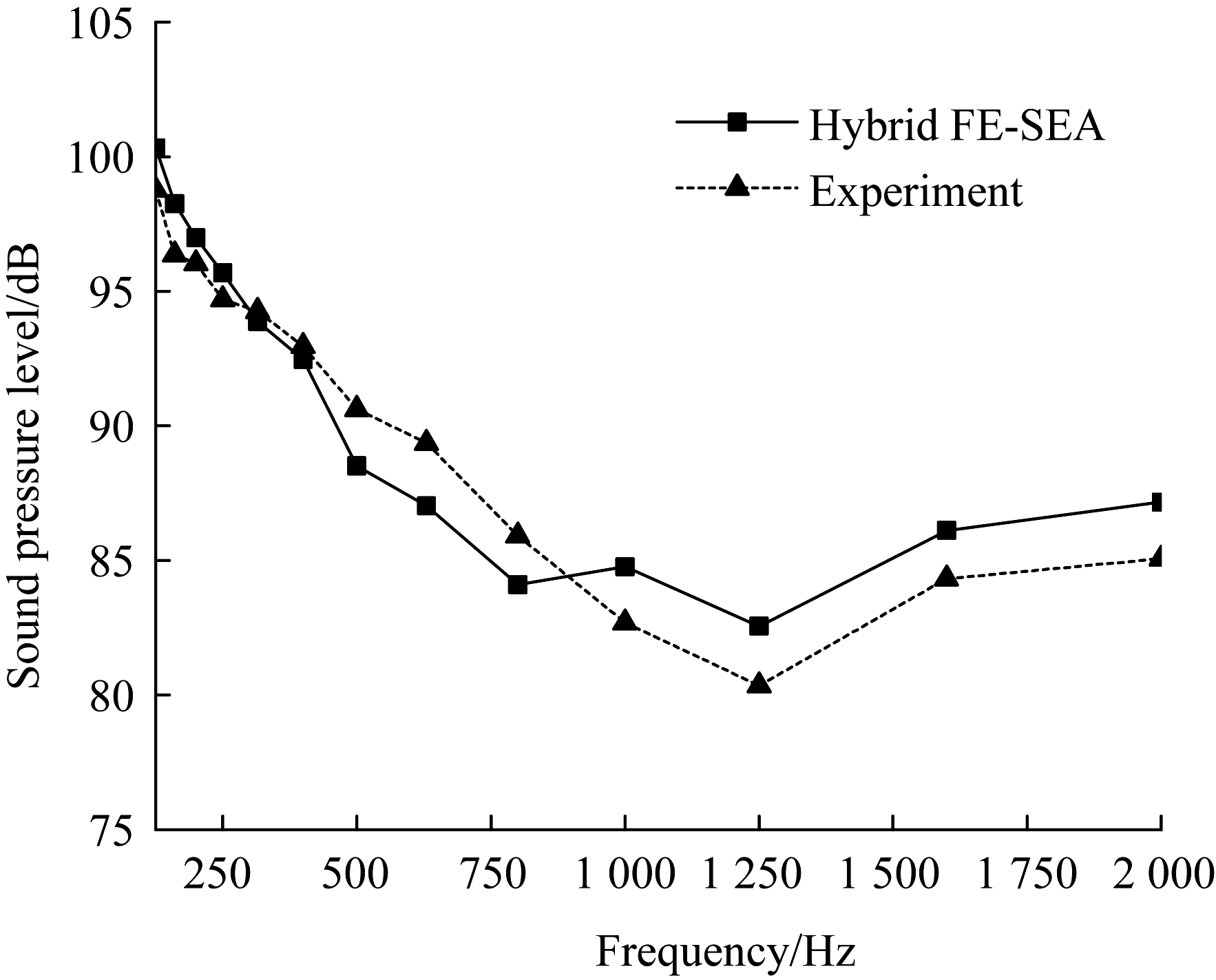
Fig.8 Sound pressure levels near the driver’s ear
1) The hybrid FE-SEA method can provide an efficient way for modeling the mid-frequency vibrations and predicting the average response over an ensemble of a random vibro-acoustic system in the middle frequencies. Compared to the conventional FE method, this method makes the computation efficient since all degrees of freedom associated by SEA subsystems are omitted from the hybrid model. On the other hand, the subsystems with uncertainties can be described statistically by SEA, without any need for a MC simulation of the ensemble.
2) In the hybrid model, substructures with few modes are modeled by the FE while substructures with many modes are modeled by SEA, which can adjust to the mixture of vibro-acoustic behavior present at middle frequencies. With the frequency increasing, the SEA subsystems tend to have sufficient randomness and the hybrid model will be more likely to meet the conditions of the diffusion field.
3) The resonance behavior of the FE subsystem at low frequencies greatly influences the response near the resonant frequency and contributes little to the frequency far from the resonant frequency.
[1]Shorter P J, Langley R S. Vibro-acoustic analysis of complex systems [J]. Journal of Sound and Vibration, 2005, 288(3): 669-699. DOI:10.1016/j.jsv.2005.07.010.[2]Roib s E, Chimeno M, López-Díez J, et al. A mode count procedure for mid-frequency analysis of complex vibro-acoustic systems [J]. Aerospace Science and Technology, 2013, 29(1): 165-174. DOI:10.1016/j.ast.2013.02.005.
s E, Chimeno M, López-Díez J, et al. A mode count procedure for mid-frequency analysis of complex vibro-acoustic systems [J]. Aerospace Science and Technology, 2013, 29(1): 165-174. DOI:10.1016/j.ast.2013.02.005.
[3]Heckl M. Structure-borne-sound[C]//Noise Generation and Control in Mechanical Engineering. Vienna: Springer, 1982: 209-287.DOI:10.1007/978-3-7091-2894-7_3.
[4]Petyt M. Introduction to finite element vibration analysis[M]. Cambridge: Cambridge University Press, 2010.
[5]Woodhouse J. An introduction to statistical energy analysis of structural vibration[J]. Applied Acoustics, 1981,14(6): 455-469. DOI:10.1016/0003-682x(81)90004-9.
[6]Lyon R H. Theory and application of statistical energy analysis[M]. Elsevier, 2014.
[7]Fahy F J. Statistical energy analysis: A critical overview[J]. Philosophical Transactions of the Royal Society A: Mathematical, Physical and Engineering Sciences, 1994, 346(1681): 431-447. DOI:10.1098/rsta.1994.0027.
[8]Burroughs C B, Fischer R W, Kern F R. An introduction to statistical energy analysis[J]. The Journal of the Acoustical Society of America, 1997, 101(4): 1779-1789. DOI:10.1121/1.418074.
[9]Babuška I, Ihlenburg F, Paik E T, et al. A generalized finite element method for solving the Helmholtz equation in two dimensions with minimal pollution [J]. Computer Methods in Applied Mechanics and Engineering, 1995, 128(3): 325-359. DOI:10.1016/0045-7825(95)00890-x.
[10]Strouboulis T, Copps K, Babuska I. The generalized finite element method: An example of its implementation and illustration of its performance [J]. International Journal for Numerical Methods in Engineering, 2000, 47(8): 1401-1417. DOI:10.1002/(sici)1097-0207(20000320)47:8<1401::aid-nme835>3.0.co;2-8.
[11]Franca L P, Farhat C, Macedo A P, et al. Residual-free bubbles for the Helmholtz equation[J]. International Journal for Numerical Methods in Engineering, 1997, 40(21): 4003-4009. DOI:10.1002/(sici)1097-0207(19971115)40:21<4003::aid-nme199>3.0.co;2-z.
[12]Soize C. Reduced models in the medium-frequency range for general external structural-acoustic systems [J]. The Journal of the Acoustical Society of America, 1998, 103(6): 3393-3406. DOI:10.1121/1.423052.
[13]Melenk J M, Babuška I. The partition of unity finite element method: Basic theory and applications [J]. Computer Methods in Applied Mechanics and Engineering, 1996, 139(1): 289-314. DOI:10.1016/s0045-7825(96)01087-0.
[14]Langley R S. A wave intensity technique for the analysis of high frequency vibrations [J]. Journal of Sound and Vbration, 1992, 159(3): 483-502. DOI:10.1016/0022-460x(92)90754-l.
[15]Mace B R. Statistical energy analysis: Coupling loss factors, indirect coupling and system modes [J]. Journal of Sound and Vibration, 2005, 279(1): 141-170. DOI:10.1016/j.jsv.2003.10.040.
[16]Shorter P J, Langley R S. On the reciprocity relationship between direct field radiation and diffuse reverberant loading [J]. The Journal of the Acoustical Society of America, 2005, 117(1): 85-95. DOI:10.1121/1.1810271.
References:
摘要:为考虑声-振结构中不确定性对系统动态响应的影响,提出了一种基于有限元方法(FEM)和统计能力分析法(SEA)相结合的混合方法.基于该方法,研究了具有不确定性的框架-板结构的中频动力学响应并以蒙特卡洛仿真结果为基准进行了对比分析.结果表明,框架-板结构的能量响应与蒙特卡洛仿真结果具有较好的一致性,验证了混合方法对具有不确定性复杂结构的中频声-振分析的有效性.基于混合FE-SEA方法,建立了具有随机特性的某工程机械驾驶室声-振模型,通过实验对模型的激励进行了测量.计算了驾驶室FE-SEA模型的声腔声压级响应与前风挡玻璃的振动功率谱密度响应,并通过实验进行了对比分析.在中频域内,二者有着较好的一致性,预测误差小于3.5 dB.
关键词:混合FE-SEA方法;动力学分析;声-振系统;不确定性;中频域
中图分类号:TP391
Received:2016-09-11.
Foundation item:s:Science and Technology Support Planning of Jiangsu Province (No.BE2014133), the Open Foundation of Key Laboratory of Underwater Acoustic Signal Processing (No.UASP1301), the Prospective Joint Research Project of Jiangsu province (No.BY2014127-01).
Citation::Jiao Renqiang, Zhang Jianrun, Xue Fei. Dynamic analysis and experimental study of vibro-acoustic system with uncertainties at middle frequencies[J].Journal of Southeast University (English Edition),2017,33(2):166-170.
DOI:10.3969/j.issn.1003-7985.2017.02.007.
DOI:10.3969/j.issn.1003-7985.2017.02.007
Biographies:Jiao Renqiang (1984—), male, graduate; Zhang Jianrun (corresponding author), male, doctor, professor, zhangjr@seu.edu.cn.